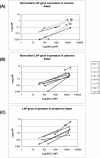Expression of a beta-defensin mRNA, lingual antimicrobial peptide, in bovine mammary epithelial tissue is induced by mastitis
- PMID: 15557657
- PMCID: PMC529112
- DOI: 10.1128/IAI.72.12.7311-7314.2004
Expression of a beta-defensin mRNA, lingual antimicrobial peptide, in bovine mammary epithelial tissue is induced by mastitis
Abstract
The expression of a beta-defensin, the lingual antimicrobial peptide (LAP), in response to mastitis was investigated by real-time PCR of RNA from mastitic and control udder quarters. There was a positive relationship between somatic cell count in milk and LAP expression. In situ hybridization showed that LAP mRNA was expressed in epithelial cells of mastitic tissue. These results suggest that LAP plays a role in the innate immune response to mastitis.
Figures


References
-
- Cullor, J., S. Wood, W. Smith, L. Panico, and M. Selsted. 1991. Bactericidal potency and mechanistic specificity of neutrophil defensins against bovine mastitis pathogens. Vet. Microbiol. 29:49-58. - PubMed
-
- Harder, J., J. Bartels, E. Christophers, and J. M. Schroder. 1997. A peptide antibiotic from human skin. Nature 387:861. - PubMed
-
- Hill, A. W., A. L. Shears, and K. G. Hibbitt. 1978. The elimination of serum-resistant Escherichia coli from experimentally infected single mammary glands of healthy cows. Res. Vet. Sci. 25:89-93. - PubMed
-
- Jia, H. P., T. Starner, M. Ackermann, P. Kirby, B. F. Tack, and P. B. McCray, Jr. 2001. Abundant human beta-defensin-1 expression in milk and mammary gland epithelium. J. Pediatr. 138:109-112. - PubMed
Publication types
MeSH terms
Substances
LinkOut - more resources
Full Text Sources
Research Materials

